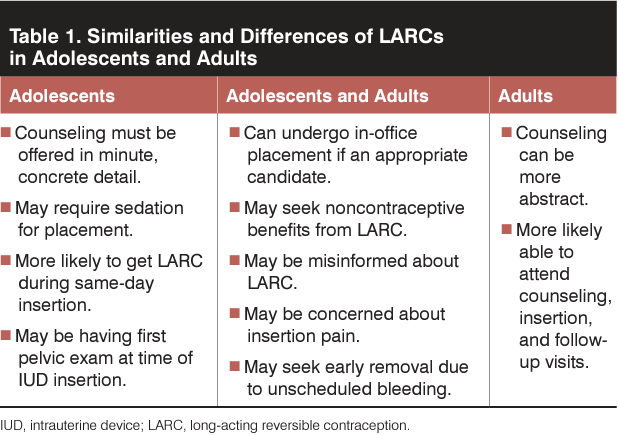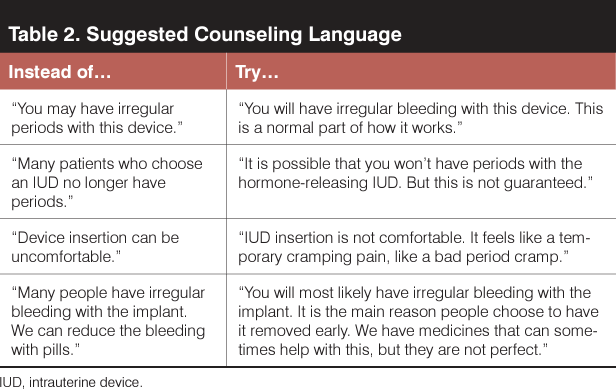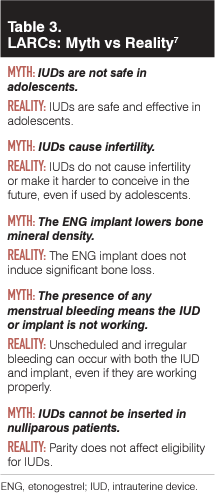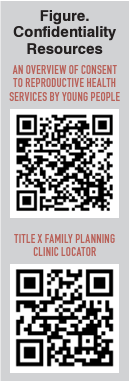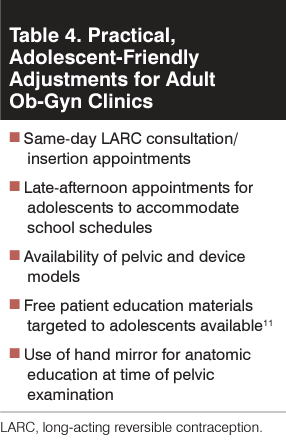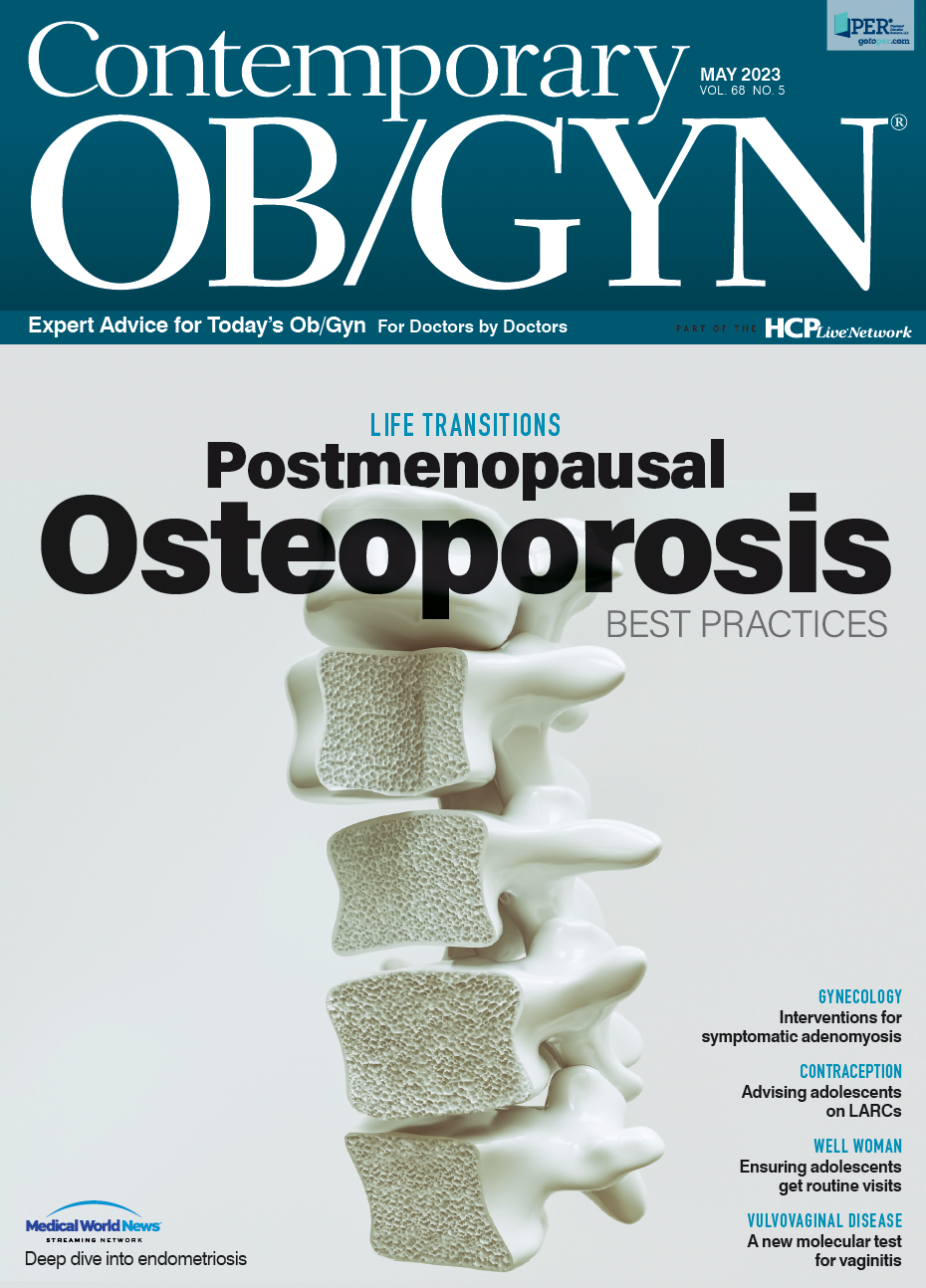Long-acting reversible contraceptives (LARCs), including subdermal implants and intrauterine devices (IUDs), are the most effective pregnancy prevention methods and offer additional benefits like suppression of menses and treatment of dysmenorrhea. Their use among adolescents is supported by organizations like the CDC, WHO, the American College of Obstetricians and Gynecologists (ACOG), and the American Academy of Pediatrics (AAP).1 High satisfaction and continuation rates (80% to 85%) with LARCs have been reported in adolescents.2-4 Despite this and the devices’ well-established benefits and efficacy, LARC use among adolescents and teens is low, at around 5% to 6%.5
Many factors contribute to such rates, including but not limited to gaps in patient and provider knowledge, concerns about confidentiality, misconceptions about complications or side effects, and unavailability of trained providers. Psychological factors may also affect adolescent use of LARCs, such as peer influence, lack of awareness about accessing LARCs, fear of weight gain, and anxiety about insertion.6 Although there are many similarities between the use of LARCs by adolescents and adults, the younger population requires counseling about confidentiality, insertion, and the management of side effects or complications (Table 1).
Counseling
Counseling is the most important part of the contraceptive visit for adolescents and serves to clarify misconceptions and set reasonable expectations. Teen counseling differs from adult counseling in that it must take into account the patient’s level of cognitive development, the influence of friends, family, and the media, and patient preferences and values regarding the use of LARCs and other contraceptives. Teenagers may require more concrete, simpler language to understand the risks and benefits of LARCs (Table 2).
Given that a very common reason for LARC discontinuation is irregular bleeding, expectations must be very clear. Adolescents, like adults, may have inaccurate ideas about these devices and think that they have a negative impact on future fertility, are very risky or painful to insert, that iatrogenic amenorrhea is unhealthy, or that they are not old enough to be eligible for LARCs (Table 3).7 It is essential to use age-appropriate language and graphics/models to explain the options and relevant side effects.
Younger patients must be reassured that they can choose when/if to have the device removed, told about expected side effects, and given online resources where they can access additional, reliable information. Because complications are very rare, LARCs may also be the best option for caregivers who must manage menstrual hygiene in children with developmental or cognitive delays.8,9
When a parent of an adolescent presents to the clinic, the subject of contraception may come up. They can be directed to adolescent-friendly educational literature and encouraged to bring the child in for her own appointment, as ACOG recommends that gynecologic appointments begin between the ages of 13 and 15.10,11 In our opinion, adolescents should be encouraged to make their own decisions about contraception at the time of their first visit, with LARCs as a recommended option.
Confidentiality
For adolescents, especially those who disclose sexual activity to their health care providers, confidentiality is key. Explicitly stating that the conversation is confidential and will not be shared with parents or guardians is essential. It may be necessary to review confidentiality documentation with the electronic health record personnel to ensure that confidential information about sexual activity and contraception is not shared online, unless the patient has explicitly chosen that it be shared. State laws should be consulted to clarify what information is considered confidential and can be obscured from parental view and what services adolescents can consent to independently. Confidentiality and consent policies for LARC vary depending on the status of the adolescent (like age), the health care setting, state laws, and insurance coverage (Figure).
Confidentiality may be breached if billing statements from medical providers and/or insurance companies include details about services performed. Therefore, the Society for Adolescent Health and Medicine, AAP, and ACOG all endorse policies and practices that reduce disclosure of confidential information in health care billing and claims processing.12 Because the risk of inadvertent disclosure still exists, however, physicians should discuss them with younger patients. If confidential services are essential to them but cannot be provided, they should be referred to federal Title X Family Planning Program clinics, where they can go for contraception services without parental knowledge (Figure).
Insertion
Patients and providers are often concerned about insertion of LARCs, particularly IUDs. Adolescents may not be forthcoming with their parents about their decision to use contraceptives and taking time off from school for pre- and post-insertion appointments may be difficult. For these patients, same-day insertion and clear confidentiality policies are vital, and they may call clinics to learn about the availability of both.13 Although multiple appointments may be a common practice with adults, it can be a prohibitive practice with youth, who may not have reliable transportation, money for several copayments, or time when they can seek reproductive services without creating suspicion among family members. Some appointments, like the one for the “string check,” may be done away with, as adolescents can be taught to do this themselves. Multiple appointments may be more feasible if clinics have extended hours (on weekends or in the late afternoon or evening on weekdays). Suggestions for adolescent-friendly practices are provided in Table 4.
Most nulliparous adolescents will have a uterine size that can accommodate a 52-mg, levonorgestrel-releasing IUD (LNG-IUD). No evidence exists to suggest that a preinsertion ultrasound is needed to assess uterine cavity size, and some literature indicates that results that deem the cavity too small may be misleading.14 There is no specific time interval after menarche at which providers may anticipate adequate uterine cavity. Therefore, the risk of expulsion or insertion failure may be higher in these patients than in adults, perhaps as high as 9%,15 and should be discussed in detail with the adolescent prior to the procedure.
Pain management for IUD placement is a significant concern for youth, although many are so satisfied with the device that they consider it worth the discomfort.16 Concerns about pain during and after the procedure are often rooted in misconceptions about IUD placement and experiences related by relatives and friends. It is crucial to discuss this uneasiness, as patient expectations should be as realistic as possible (Table 3).7 Anticipated pain is known to be associated with perceived pain in adolescents, and Black adolescents experience greater anticipated pain.17 Although studies have shown the efficacy of NSAIDs for pain control, no data exists to show a significant difference between paracervical block and sham for control of procedural and post-procedural pain.16 Nitrous oxide has been shown to reduce patient-reported pain and to be associated with higher satisfaction among adolescents.18 In very young individuals and in those with developmental delay, it is advisable to insert the IUD under sedation, as pelvic examination can be traumatizing. There is limited data comparing the pain associated with different IUD types. A small study of adolescents recently showed lower pain scores with the copper IUD and the levonorgestrel 10.5-mg IUD than with the levonorgestrel 52-mg IUD, although the differences were small.19
Adolescents undergoing in-office insertion may be having their first pelvic examination. Clinicians should keep this in mind to minimize negative experiences. As with all best practices, clinicians should present as relaxed, unhurried, and positive. Use of a hand mirror can provide anatomic education and may prolong the examination.
Complications/discontinuation
LARC complications are uncommon but should be discussed in detail with the adolescent ahead of time. Bleeding irregularity is a leading reason for discontinuation of both LNG-IUD and the contraceptive implant.20 Frequently, patients will need additional reminders about typically expected unscheduled bleeding. The LNG-IUD’s bleeding profile should improve over time, but amenorrhea may not be a reasonable expectation, with reported rates as low as 39%.21 As with adults, unscheduled bleeding beyond a reasonable timeframe (6 months) may warrant ultrasound evaluation. Transabdominal ultrasonographic evaluation of device location is typically sufficient (transvaginal is not strictly necessary) and certainly preferred in adolescents who have not yet reached coitarche. Similarly, pelvic pain after IUD insertion may signal a mislocated device, and further evaluation is warranted.
The management of irregular bleeding with the ENG implant poses challenges akin to those of management in adults. There is some evidence to support offering a 7-day course of tamoxifen (off-label), as it has been shown to reduce symptoms and prolong time to implant removal in adolescents.22,23 Alternatively, patients may be prescribed estrogens, like combined hormonal contraceptives (CHC), to mitigate unscheduled bleeding. This option is naturally less appealing to those who selected LARC to avoid taking a pill.
Another complaint leading to early LNG-IUD discontinuation is acne.21 It is not uncommon for adolescents to switch to LNG-IUD from a CHC regimen that reduces sebum production. When counseling adolescents already on CHCs about LARC, it is important to mention that this may be a side effect of discontinuing the estrogen. Evidence-based practice for adolescent acne includes adapalene and benzoyl peroxide as first-line topical agents, and gynecologists can consider spironolactone as an adjunct, particularly in patients complaining of hirsutism. Acne in adolescence is very common, and the gynecologist may consider a referral to a dermatologist.
Adolescents should be shown a model of an IUD so that they can recognize it should they experience expulsion. Caregivers of nonverbal or developmentally delayed adolescents should also be educated about this risk and the appearance of the device. Sudden changes in menstrual flow should prompt adolescents and caregivers to seek evaluation for expulsion (either via ultrasound or vaginal exam) because the devices are not always seen after expulsion.
Conclusions
Efficacy, satisfaction, and continuation rates for LARCs are high among adolescents. But there are nuances to consider in terms of counseling and insertion. Misconceptions among providers as well as patients can lead to underutilization. LARCs should be offered and made available to adolescent patients for both contraceptive and noncontraceptive uses.
Takeaways
- Counseling is the most critical aspect of providing LARCs to adolescents, as expectation-setting improves device lifespan.
- Nulliparity and adolescence are not contraindications to IUD insertion.
- Evaluating the clinic for “adolescent-friendliness” is important because these patients face transportation and social challenges that distinguish them from adults (eg, availability of same-day consultation and insertion appointments).
- As with adults, the best contraceptive choice for the adolescent is the one they are willing to use.
- Confidentiality is an important consideration. Title X clinics can provide all adolescents with contraception services without parental involvement or consent, irrespective of state laws.
References
1. Espey E, Yoder K, Hofler L. Barriers and solutions to improve adolescent intrauterine device access. J Pediatr Adolesc Gynecol. 2019;32(5s):S7-s13. doi:10.1016/j.jpag.2019.03.010
2. Secura GM, Allsworth JE, Madden T, Mullersman JL, Peipert JF. The Contraceptive CHOICE Project: reducing barriers to long-acting reversible contraception. Am J Obstet Gynecol. 2010;203(2):115.e1-115.e1157. doi:10.1016/j.ajog.2010.04.017
3. Rosenstock JR, Peipert JF, Madden T, Zhao Q, Secura GM. Continuation of reversible contraception in teenagers and young women. Obstet Gynecol. Dec 2012;120(6):1298-1305. doi:10.1097/aog.0b013e31827499bd
4. Friedman JO. Factors associated with contraceptive satisfaction in adolescent women using the IUD. J Pediatr Adolesc Gynecol. 2015;28(1):38-42. doi:10.1016/j.jpag.2014.02.015
5. ACOG Committee Opinion No. 735: Adolescents and long-acting reversible contraception: implants and intrauterine devices. Obstet Gynecol. 2018;131(5):e130-e139. doi:10.1097/aog.0000000000002632
6. Patel PR, Lee J, Abacan A, Vivens M, Smith PB. Psychological factors that may influence use of long-acting reversible contraceptives (LARC): a qualitative study. Bull Menninger Clin. 2022;86(4):300-315. doi:10.1521/bumc.2022.86.4.300
7. Kirubarajan A, Li X, Yau M, et al. Awareness, knowledge, and misconceptions of adolescents and young people regarding long-acting reversible contraceptives: a systematic review and meta-analysis. Fertil Steril. 2022;118(1):168-179. doi:10.1016/j.fertnstert.2022.03.013
8. Schwartz BI, Alexander M, Breech LL. Intrauterine device use in adolescents with disabilities. Pediatrics. 2020;146(2): e20200016. doi:10.1542/peds.2020-0016
9. Lutz CM, Onwuka A, Lawrence AE, Richards H, Deans KJ, McCracken K. Levonorgestrel-Releasing Intrauterine System Utilization in Patients with Developmental Delays. J Pediatr Adolesc Gynecol. 202336(1):79-82. doi:10.1016/j.jpag.2022.09.003
10. Committee Opinion No. 710: Counseling adolescents about contraception. Obstet Gynecol. 2017;130(2):e74-e80. doi:10.1097/aog.0000000000002234
11. NASPAG Patient Handouts. NASPAG. Accessed March 11, 2023. https://www.naspag.org/patient-handouts
12. Society for Adolescent Health and Medicine; American Academy of Pediatrics. Confidentiality protections for adolescents and young adults in the health care billing and insurance claims process. J Adolesc Health. 2016;58(3):374-377. doi:10.1016/j.jadohealth.2015.12.009
13. Lim SE, Krajewski CM. A mystery shopper study identifying practice-level barriers to adolescent IUD access in western Pennsylvania. Contraception. Feb 2020;101(2):130-131. doi:10.1016/j.contraception.2019.10.011
14. Savasi I, Jayasinghe K, Moore P, Jayasinghe Y, Grover SR. Complication rates associated with levonorgestrel intrauterine system use in adolescents with developmental disabilities. J Pediatr Adolesc Gynecol. 2014;27(1):25-28. doi:10.1016/j.jpag.2013.08.010
15. Keenahan L, Bercaw-Pratt JL, Adeyemi O, Hakim J, Sangi-Haghpeykar H, Dietrich JE. Rates of intrauterine device expulsion among adolescents and young women. J Pediatr Adolesc Gynecol. 2021;34(3):362-365. doi:10.1016/j.jpag.2020.11.003
16. Akers AY, Harding J, Perriera LK, Schreiber C, Garcia-Espana JF, Sonalkar S. Satisfaction with the intrauterine device insertion procedure among adolescent and young adult women. Obstet Gynecol. 2018;131(6):1130-1136. doi:10.1097/aog.0000000000002596
17. Hunter TA, Sonalkar S, Schreiber CA, Perriera LK, Sammel MD, Akers AY. Anticipated pain during intrauterine device insertion. J Pediatr Adolesc Gynecol. 2020;33(1):27-32. doi:10.1016/j.jpag.2019.09.007
18. Fowler KG, Byraiah G, Burt C, Lee DB, Miller RJ. Nitrous oxide use for intrauterine system placement in adolescents. J Pediatr Adolesc Gynecol. 2022;35(2):159-164. doi:10.1016/j.jpag.2021.10.019
19. Anjos FCQS, Marcelino AC, Espejo-Arce X, et al. Pain and ease of insertion of three different intrauterine devices in Brazilian adolescents: a participant-blinded randomized trial. Contraception. 2023;109997. doi:10.1016/j.contraception.2023.109997
20. Schmidt EO, James A, Curran KM, Peipert JF, Madden T. Adolescent experiences with intrauterine devices: a qualitative study. J Adolesc Health. 2015;57(4):381-386. doi:10.1016/j.jadohealth.2015.05.001
21. Oliveira ECFD, Baêta T, Cotta RCF, Rocha ALL. Use of 52-mg levonorgestrel-releasing intrauterine system in adolescents and young adult women: 3-year follow-up. J Pediatr Adolesc Gynecol. 2023;36(1):45-50. doi:10.1016/j.jpag.2022.09.001
22. Friedman JC, Buyers E, Laurin J, Hampanda K, Alaniz VI. Tamoxifen for the treatment of etonogestrel implant-associated bleeding in an adolescent gynecology practice. J Pediatr Adolesc Gynecol. 2022;35(3):341-345. doi:10.1016/j.jpag.2021.11.001
23. Edelman AB, Kaneshiro B, Simmons KB, et al. Treatment of unfavorable bleeding patterns in contraceptive implant users: a randomized controlled trial. Obstet Gynecol. 2020;136(2):323-332. doi:10.1097/aog.0000000000003896

